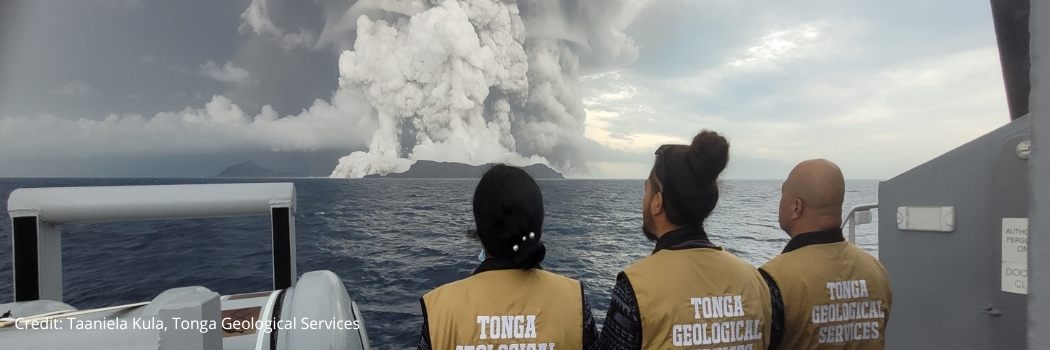Explosive volcanic eruption led to record-breaking underwater flows

Research involving our Departments of Earth Sciences and Geography has revealed how an explosive volcanic eruption triggered the fastest underwater flows ever recorded and led to extensive damage of seafloor cables.
Avalanche-like flows
The research team, which was led by scientists from the National Oceanography Centre (NOC), studied the huge eruption of the submerged Hunga Volcano in January 2022 which triggered fatal tsunamis and pressure waves that travelled around the globe. This was the most explosive eruption on Earth in over 100 years.
The study, published in Science, shows that there were major impacts far below the sea surface as erupted volcanic material plunged into the ocean, creating avalanche-like flows which travelled at speeds of up to 122km/hour along the seafloor.
This flow broke the only seafloor cable that connected the Kingdom of Tonga to the global telecommunications network, as well as the only internal cable within Tonga. These cable breaks severely hampered disaster relief efforts, and initially made it impossible for many residents of Tonga to contact their loved ones abroad.
Collaboration in a crisis
Subsea cables underpin our daily lives and carry more than 99% of all digital data traffic globally. Tonga’s only international cable was abruptly served during the eruption disconnecting the whole nation from the rest of the world during a volcanic crisis.
Professor Peter Talling, an oceanographer in our Departments of Earth Sciences and Geography, brought together an international team of scientists and industry collaborators immediately after the eruption occurred to find out what caused the disruption.
The team sampled and surveyed the seafloor providing evidence to show that powerful and dense subsea currents caused the cable damage.
The study determined that the extremely fast flows were caused by collapses of the eruption plume, falling directly into the ocean onto very steep underwater slopes.
Their initial speed was so fast that these underwater flows were capable of running several hundred meters uphill and for at least one hundred kilometres across the seafloor, giving deeper insight into the widespread damage to the seafloor cables.
Future resilience
The timings and locations of the cable damage allowed researchers to determine the speeds of eruption-triggered seafloor flows for the first time and to better understand the hazards of other submerged volcanoes worldwide.
The insight from this research will help industry experts to understand risk better and improve the resilience of cable systems in other volcanically-active regions.
Find out more:
- Read the full research paper in Science
- Discover more about the work of Professor Peter Talling
- Read BBC coverage of this research
Earth Sciences at Durham University
Our Department of Earth Sciences is ranked in the world top 50 by the QS World University Rankings. The department aspires to help shape the future by providing the highest quality education for our students and by undertaking research that is both intrinsically excellent and relevant to society.
Feeling inspired? Visit our Earth Sciences webpages to learn more about our postgraduate and undergraduate programmes.
Durham University is a top 100 world university. In the QS World University Rankings 2024, we were ranked 78th globally.
Geography at Durham University
We are a world-leading centre of geographic education, ranked joint 14th in the QS World University Rankings by Subject 2023.
Our success as a department is a measure of the open, inclusive environment we foster for students. To be a member of Durham Geography is to be welcomed by a community that wants you to succeed and creates an environment to make it happen.
Feeling inspired? Visit our Geography webpages to find out more about studying with us.
Durham University is a top 100 world university. In the QS World University Rankings 2024, we were ranked 78th globally.


/prod01/prodbucket01/media/durham-university/departments-/earth-sciences/60228-1-1998X749.jpg)